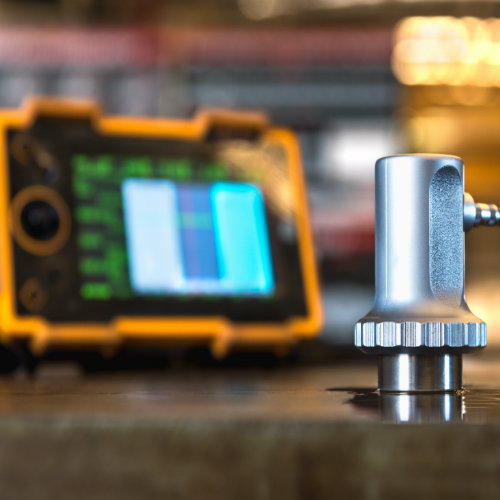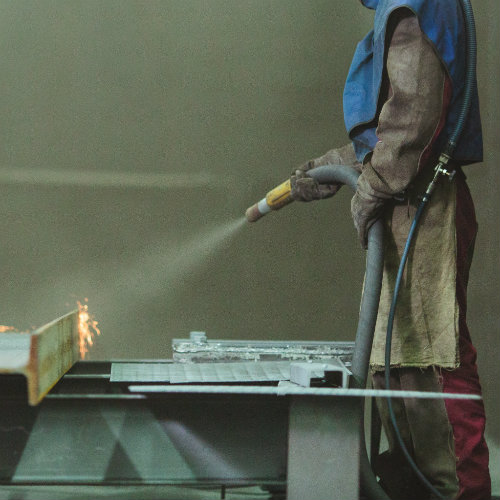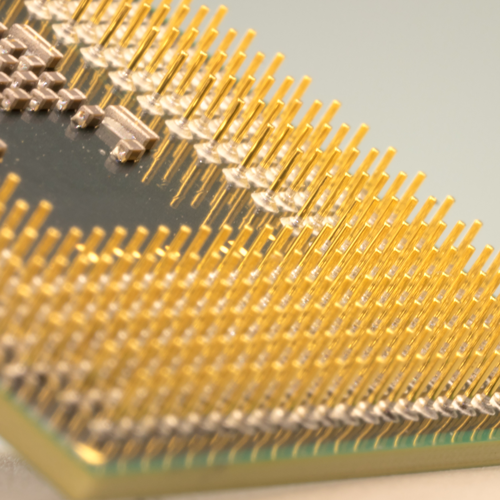Electroless Nickel Plating
Electroless nickel plating is a unique process that uses heat and a unique chemical bath to create the nickel without the use of
Since electroless nickel finishing does not use electricity, the coating created by the process is very uniform across the entire surface of the part, even parts with complex geometry. Threads and close tolerance features can be plated precisely without edge build up.
Electroless nickel has anti-galling properties that chromium does not. Electroless nickel’s low coefficient of friction reduces wear when compared to electrolytic nickel and chromium plating.
Electroless nickel has greater corrosion resistance per mil thickness than any electrodeposited nickel due to a general lack of pore structure.
The oil and gas industry uses electroless nickel for its hardness and exceptional corrosion and
In the industrial plating field, many companies use low phosphorous electroless nickel to replace chrome plating. This can reduce costs by either reducing or eliminating post plate grinding processes.
The Aerospace and Electronics industries use electroless nickel finishing for many reasons. It covers very uniformly, reducing after plating machining. It has good corrosion resistance when comparing it to other nickel coatings of the same thickness.
Valence Surface Technologies offers all three types of electroless nickel plating
Low Phosphorous Electroless Nickel (Hard)
Low phosphorous electroless nickel plating utilizes a unique bath providing an as-plated deposit hardness of up to 60 Rockwell. This bath provides a deposit nearly as hard as Hard Chrome, with the advantage of a uniform thickness inside complex configurations, as well as outside. The deposit is so uniform that grinding after plating is often eliminated. Low phosphorous electroless nickel offers excellent resistance to alkaline, corrosive environments and is also used for its weldability and solderability in the electronics industry.
Medium Phosphorous
This is the workhorse electroless nickel. It has proven itself over the years. Steel parts plated with Medium Phosphorous electroless nickel will in many cases perform like stainless steel. Electroless nickel will not build up on edges or ends, and it plates inside and out giving uniform total coverage. With heat treatment, medium phosphorous electroless nickel can be hardened from 45 Rockwell C to as high as 68 Rockwell C.
High Phosphorous
This finish provides maximum corrosion resistance. High Phosphorous electroless nickel finishing is standard in industries that require resistance to strongly acidic corrosive environments as well as any industry that requires a pore-free finish.
Request a quote on electroless nickel plating for your application, or contact Valence Surface Technologies for more information.

Black Anodize Electroless Nickel Process

Electroless Nickel Process
Electroless nickel plating is used in the aerospace and electronics industries for many reasons. It covers very uniformly, reducing after plating machining. In addition, it has good corrosion resistance compared to nickel coatings of the same thickness. The oil and gas industry uses electroless nickel for its hardness and exceptional corrosion and resistance in that working environment.
In the industrial plating field, many companies use low-phosphorus electroless nickel to replace chrome plating. This can reduce costs by either reducing or eliminating post-plate grinding processes.
What Is Electroless Nickel Plating?
The autocatalytic chemical reduction of a nickel-alloy coating used for surface finishing (most frequently Nickel Phosphorus) results in Electroless Nickel Plating (ENP). The electric current typically used in electroplating is not used to complete this process. Instead, nickel ions are reduced with a chemical reducing agent, like sodium hypophosphite, to form ENP, which is then deposited.
The Nickel-Phosphorus alloy, which usually contains between 2% and 14% phosphorus, is deposited in a very even layer via the ENP method. The advantages of this coating for parts include resistance to corrosion, enhanced hardness, resistance to wear, and an anti-galling surface. In addition, the coating becomes amorphous at higher phosphorus concentrations, implying that no grain boundaries could serve as corrosion initiation sites. This makes the
coating perfect for protecting against corrosion.
Types Of Electroless Nickel Plating
There are different types of electroless nickel plating based on the application intended. They are:
Electroless Nickel: Corrosion Protective Finishes
- Low Phosphorus Electroless Nickel
- Mid-Phosphorus Electroless Nickel
- High Phosphorus Electroless Nickel
Electroless Nickel: Wear Resisting Finishes
- Boron Electroless Nickel
- Composite Electroless Nickel Coatings
- Carbides/Diamonds
- Polymers
Low Phosphorus Electroless Nickel
This electroless nickel bath, which has up to 5% phosphor, was created to withstand conditions with higher temperatures to provide enhanced hardness and reduced wear. It also inhibits improved solderability and increased electrical conductivity due to the low level of alloyed phosphor.
When exposed to acidic conditions, corrosion protection is inadequate compared to good protection in high pH (alkaline) situations, such as the chemical production of caustic soda and chlorine. Compressive stress is produced by this alloy, reducing the likelihood of fatigue failure in steel alloys. Comparing this to deposits of boron electroless nickel, it is a more affordable option.
Mid-Phosphorus Electroless Nickel
Mid-phosphorus electroless nickel offers moderate resistance to corrosion and wear and contains 5% to 9% phosphor. Typically, this coating is bright. Compared to alternative electroless nickel bath formulations, the bath is the most cost-effective.
It is an excellent option for restoring the tolerance of undersized parts. The fact that this bath deposits a modest amount of tensile stress onto steel is a major issue.
High Phosphorus Electroless Steel
Since they create a truly amorphous (glass-like) surface devoid of any crystalline structures, high phosphorous baths—defined as having above 10% phosphor—form the ideal deposit for the most corrosive atmospheres. They normally do not have deposits that are more than 13% phosphor. High phosphorus electroless nickel is an excellent choice for electronics that need shielding properties to prevent interference from other electronic equipment because it is fully non-magnetic as plated.
Boron Electroless Nickel
0.5% to 5% of the electroless nickel baths include boron. Boron electroless nickel coatings can be divided into two major categories. The first class is designed for usage in the electronics industry and has lower levels of boron (0.5% to 3%) for increased solderability and conductivity. Due to their enhanced hardness and wear resistance compared to phosphorus electroless nickel coatings, the second class of these coatings is used. As plated, the high boron electroless nickel (3-5%) coating is as hard as chrome, but it can be heat treated even harder. The automotive and aerospace industries primarily utilize this second class of boron electroless nickel coating for replacing chrome plating.
However, boron electroless nickel coatings are a poor choice for corrosion protection compared to phosphorus electroless nickel coatings because they have higher internal deposit stress, creating more porosity.
Composite Electroless Nickel Coatings
By adding particles to the bath, which then become occluded (deposited) with the nickel alloy, electroless nickel composite coatings are produced. The diameter of these particles varies from 0.5 to 10 um (20 to 400 u”). Particle content in the typical composite electroless nickel coating ranges from 10% to 30%.
These composite coatings can incorporate both hard and soft particles in one uniform coating and work well with any matrix electroless nickel baths. The novel electroless nickel matrix’s potential results will depend on the volume ratio of the hard and soft particles as well as the technique used.
Carbides/Diamonds
Minerals and ceramics are extremely durable and frequently practically unbreakable. Since they have very high hardness values and very high melting temperatures, they make a wonderful choice because they lessen the abrasion and wear loss of the overall electroless nickel composite coating. Composite finishes are as harsh and lifeless as plating.
Grinding and buffing done after plating could enhance the aesthetics. In comparison to boron and phosphorus electroless nickel plating alone, these coatings cost more (see table below). Aluminum oxide, silicon carbide, tungsten carbide, and, in extremely rare circumstances, diamonds or other mined minerals are a few examples of the different sorts of particles.
Polymers
Fluorocarbon-based polymers are used to minimize wear and friction on a part. The range of particle composition by volume for the majority of electroless nickel composite polymer coatings is 10 to 30%. These polymers can be equally distributed across the nickel covering and occluded within it. When plated, the coating appears matte gray to chalk white.
TeflonTM is the most widely used fluorocarbon coating. The range of particle sizes is the same as that of hard particle sizes. Good release and anti-galling qualities are produced by these coatings. While some fluorocarbons, like Teflon, have greater melting points closer to 1000° C (1832° F), the majority of polymers have significantly lower melting points than hard particles and start to melt at roughly 330° C (626° F).
Electroless Vs. Electrolytic Nickel Plating
We have already described what electroless plating is. To make a comparison between electroless and electrolytic nickel plating, we need to define what electrolytic nickel plating is.
What Is Electrolytic Nickel Plating?
Cleaning and pretreating the substrate are the first steps in electrolytic plating, just like in electroless nickel plating. The item is then submerged in a bath of positively charged nickel and a conductive base. After the object has been immersed, the solution is given an external electrical current or rectifier.
The plating procedure is finished when electricity charges the nickel anodes, causing them to release ions that adhere to the substrate’s surface.
Advantages Of Electroless Nickel Plating Over Electrolytic Nickel Plating
More Uniform Deposit Thickness
With tolerances of +/-.0001 inches, electroless nickel plating is more accurate than electrolytic plating. The “dog bone effect,” which happens when too many amps per square foot are applied during electrolytic plating and results in an uneven deposit, can be avoided by using it to produce complicated geometries.
Superior Corrosion Resistance
The addition of phosphorus to the solution improves ENP’s resistance to corrosion.
Improved EMI Shielding
Additionally, phosphorus has magnetic qualities that enable metal finishers to regulate the amount of electromagnetic interference surrounding the substrate. For applications that involve electronics, this characteristic has been shown to be essential.
Additional Hardness and Durability
Heat treatment of ENP deposits can increase their hardness to 90% of that of chromium. As-plated, low-phosphorus ENP coatings have a Rockwell scale (Rc) rating of up to 63. Comparatively, the as-plated hardness of type II brilliant nickel deposits produced by electrolytic plating is 50+ Rc.
Enhanced Lubricity
Additionally, electroless nickel plating reduces surface scarring and friction with other materials, improving lubricity.
Increased Ductility
Compared to conventional nickel coating, ENP is more ductile, making it less prone to shatter, break, or crack under pressure. However, Type I pure nickel plating offers a comparable degree of ductility and is capable of exceeding AMS2424 standards set by SAE International.
Greater Coating Versatility
The thickness of the layer can be almost any size with electroless nickel plating, and it can be applied to almost any metallic substrate.
Salvageability
ENP is a great option for materials that will eventually be salvaged.
Advantages Of Electrolytic Nickel Plating Over Electroless Nickel Plating
Material Purity
While electroless nickel plating needs phosphorus, electrolytic plating can be created entirely from nickel. Other metal materials, like copper, for instance, can be used in the plating process.
Increased Scalability
Electrolytic plating can provide higher production quantities with shorter lead times and is typically less expensive than electroless nickel plating, making it a marginally more productive technique.
Enhanced Conductivity
Compared to electroless nickel plating, a higher nickel content offers improved conductivity.
Improved Heat-Resistance
Nickel deposits can resist temperatures of up to 1,832°F after processing.
What Is It Used For?
Electroless nickel plating is versatile and has many benefits. It imparts hardness to the surface and protects parts from corrosion, abrasion, and natural wear for all kinds of applications under various situations. The following industries are the ones that employ electroless nickel plating the most.
- Aerospace
- Construction
- Electronics
- Engineering
- Oil & Gas
- Automobile
What Metals Can Be Electroless Nickel Plated?
When exposed to different environmental factors and corrosive applications over time, raw metals other than precious metals can easily oxidize and corrode.
Any component’s correct design must start with a surface engineering assessment to guarantee that the final product will perform consistently for the duration of its designated service life. Corrosion can cause functional problems and shortcomings even in relatively low-stress service applications.
Galvanic corrosion, chemical assault, erosion, and other corrosive mechanisms can all be effectively countered by electroless nickel plating. Steel, copper, brass, and aluminum alloys are just a few examples of the many base metals that can receive electroless nickel plating (ENP). Electroless Nickel plating is currently utilized to promote corrosion protection performance across a diverse range of industries, including heavy equipment, oil & gas, power transmission & distribution, automotive, marine, and railway, to name a few.
What Are The Benefits Of Electroless Nickel Plating?
The Electroless Nickel Plating process offers various advantages over traditional electroplating that make it a reliable surface finishing treatment:
Corrosion Protection
Compared to electroplated nickel, electroless nickel is less porous, making it highly hard and resistant to typical corrosives such as salt water, carbon dioxide, oxygen, and hydrogen sulfide.
Cost-Efficient
Since the coating is produced using a precise and effective method without the need for energy, it is cost-effective for a variety of applications. This durable, high-quality finish can be produced for less money upfront and with less equipment than traditional electroplating. The finish adds to cost savings over the equipment’s lifetime by extending the service life of parts.
Uniformity
An extremely even coating is achieved during the ENP process. The auto-catalytic nature of this process prevents key parts of your item from being over- or under-plated because there are no high-current or low-current zones. Engineered coatings have tight controllable thickness and no edge buildup. With this method, even complicated geometries may be coated equally.
Hardness
Low (2-4%), mid (5-9%), and high (10-14%) concentrations of phosphorus are present in several types of ENP baths. The final application determines which bath should be used. High phosphorus EN (10-14%) offers the best corrosion protection while offering the lowest amount of hardness, whereas low phosphorus EN (2-4%) offers the highest hardness while offering the lowest level of corrosion protection. The best of both worlds is offered by the mid-level phosphorus (5–9%), which many clients prefer.
Disadvantages Of Electroless Nickel Plating
To increase the adherence of the nickel and lessen internal tensions inside the nickel that has been deposited on parts that are prone to corrosion via usage, post-heat treatment may be required. Hydrogen embrittlement is still a possibility for electroless nickel-plated parts.
It’s crucial to watch out during heat-treating electroless nickel so as not to temper-soften the already-existing material.
How Much Does Electroless Plating Cost?
One of the most frequent questions we get is, “how much should electroless nickel plating cost?” What company isn’t looking for ways to save costs in today’s economy? If metal plating is necessary for your business, electroless nickel plating may provide the economical answer you’re looking for.
Unlike electroplating, which uses an electrical current or other external power sources to cover a metal surface, electroless nickel plating does not. As a result, electroless nickel plating is less expensive than electroplating since nickel is frequently less expensive to plate than costly metals like gold, platinum, and silver.
Factors Impacting Electroless Nickel Plating Costs
The features of the coating, the necessity for atmospheric protection, the required hardness and wear properties, market conditions, component availability, and the complexity of the coating process can all have a significant impact on the price of the electroless nickel matrix.
A high-end, competitive Parts Finishing now costs more due to the requirement for more synergistic specialized matrix coatings, although the price of a basic electroless nickel phosphorous matrix coating has decreased.
The most straightforward strategy to reduce electroless nickel plating expenses is generally to utilize a bath matrix made of a nickel-phosphorus alloy, provided that your firm can benefit from it and that it is compatible with the metal parts you use or produce. The most expensive electroless nickel plating is frequently required for a nickel-boron composite.
Electroless Nickel Plating Services
Valence surface technologies offer all three types of electroless nickel plating such as:
Low Phosphorus Electroless Nickel (Hard)
Low phosphorus electroless nickel plating makes use of a special bath that can make the plated layer as hard as 60 Rockwell. This bath offers a deposit that is almost as hard as Hard Chrome, with the benefit of a uniform thickness both inside and outside of complex arrangements.
Because of the uniformity of the deposit, grinding is frequently skipped after plating. Low phosphorus electroless nickel is used in the electronics industry for its weldability, solderability, and strong resistance to alkaline, corrosive conditions.
The workhorse electroless nickel is this. Over time, it has demonstrated its worth. In many situations, steel pieces that have been electroless nickel plated with medium phosphorus will behave like stainless steel.
Electroless nickel plates inside and out provide consistent entire coverage and won’t accumulate on edges or ends. Medium phosphorus electroless nickel can be toughened via heat treatment from 45 Rockwell C to 68 Rockwell C.
High Phosphorous
This finish provides maximum corrosion resistance. High Phosphorus electroless nickel finishing is standard in industries that require resistance to strongly acidic corrosive environments as well as any industry that requires a pore-free finish.
Request a quote on electroless nickel plating for your application, or contact Valence Surface Technologies for more information.
Conclusion
One of the most important things to do in order to get a quality finish on electroless nickel plating is to find a reliable partner. Valence surface technologies have proven expertise to exceed your metal finishing and plating needs.
You can find out more about our electroless nickel plating service or contact us today to discuss your specification requirements.







